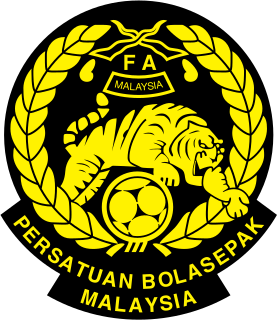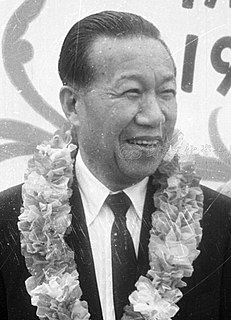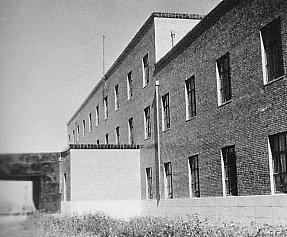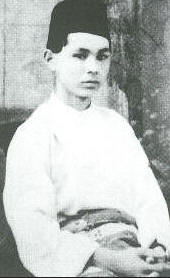Isoroku Yamamoto's sleeping giant quotation is a film quote by the Japanese Admiral Isoroku Yamamoto regarding the 1941 attack on Pearl Harbor by forces of Imperial Japan.
Malaya refers to a number of historical and current political entities related to what is currently Peninsular Malaysia in Southeast Asia.

The Malaysia national football team represents Malaysia in international football and is controlled by the Football Association of Malaysia. The national team is recognised by FIFA as the successor of the defunct Malaya national football team which was founded for the 1963 Merdeka Tournament one month before the institution of Malaysia. The team is officially nicknamed Harimau Malaya in reference to the Malayan tiger.

Force Z was a British naval squadron during the Second World War, consisting of the battleship HMS Prince of Wales, the battlecruiser HMS Repulse and accompanying destroyers. Assembled in 1941, the purpose of the group was to reinforce the British colonial garrisons in the Far East and deter Japanese expansion into British possessions, particularly Malaya and Singapore. Lack of aircraft to protect Force Z, underestimation of the Japanese armed forces and the political rather than naval motive for its deployment, are blamed for the destruction of the force.

Radio Televisyen Malaysia (RTM), also known as the Department of Broadcasting, Malaysia is the national public broadcaster of Malaysia. Established on 1 April 1946 as Radio Malaya, it is the first and the oldest broadcaster in the country. After Malaysia was formed on 16 September 1963, Radio Malaya was renamed Radio Malaysia. On 28 December the same year, television service in Malaysia began with the establishment of Televisyen Malaysia. In 1969, Radio Malaysia and Televisyen Malaysia merged to form the present day broadcast department. Radio Televisyen Malaysia monopolised the free-to-air television until 1984 and radio until 1988, when private television and radio stations such as TV3 and Best FM begin to exist. Currently, it operates 6 television channels and 34 radio stations nationwide.

The cinema of Malaysia consists of feature films produced in Malaysia, shot in the languages Malay, Mandarin, Cantonese, Tamil, various indigenous languages, and English.

The Cathay Building was opened in 1939 by Dato Loke Wan Tho as the headquarters for the British Malaya Broadcasting Corporation. Located at 2 Handy Road in the Museum Planning Area of Singapore, the building was most known for its air-conditioned theatre known as the Cathay Cinema, then a technological marvel and the first to be built in Singapore. Cathay Building was the first skyscraper in Singapore and tallest building in Southeast Asia at that time.

The then British colony of Malaya was gradually occupied by the Japanese between 8 December 1941 and the Allied surrender at Singapore on 16 February 1942. The Japanese remained in occupation until their surrender to the Allies in 1945. The first Japanese garrison in Malaya to lay down their arms was in Penang on 2 September 1945 aboard HMS Nelson.

Susumu Fujita was a Japanese film and television actor. He played the lead role in Akira Kurosawa's first feature, Sanshiro Sugata, and appeared in other Kurosawa films including The Men Who Tread On the Tiger's Tail and The Hidden Fortress. Later, he was a supporting actor in Ishirō Honda's Mothra vs. Godzilla, among many other films.
Events in the year 1988 in Japan. It corresponds to Shōwa 63 (昭和63年) in the Japanese calendar.

Runme Shaw, K.St.J was the chairman and founder of the Shaw Organisation of Singapore. Runme Shaw and his brother, Run Run Shaw, together known as the Shaw Brothers, were pioneers in the film and entertainment industry in Singapore and Malaya, and brought to life the movie industry in Asia, especially the Southeast Asian region.

The British Military Administration (BMA) was the interim administrator of British Malaya from August 1945, the end of World War II, to the establishment of the Malayan Union in April 1946. The BMA was under the direct command of the Supreme Allied Commander South East Asia, Lord Louis Mountbatten. The administration had the dual function of maintaining basic subsistence during the period of reoccupation, and also of imposing the state structure upon which post-war imperial power would rest.

Manchukuo Film Association Corporation or Man'ei (滿映) was a Japanese film studio in Manchukuo during the 1930s and 1940s.

The Japanese Cemetery Park is a Japanese cemetery and park in Hougang, Singapore. It is the largest Japanese cemetery in Southeast Asia at 29,359 square metres, consisting of 910 tombstones that contain the remains of members of the Japanese community in Singapore, including young Japanese prostitutes, civilians, soldiers and convicted war criminals executed in Changi Prison. It was gazetted as a memorial park by the Singapore government in 1987.

Storm Over the Pacific is a 1960 color (Eastmancolor) Japanese film directed by Shūe Matsubayashi. The story is an account of a young Japanese bombardier, Lt. Koji Kitami stationed aboard the Japanese aircraft carrier Hiryu and his participation in two battles in the Pacific during World War II, the attack on Pearl Harbor and the Battle of Midway.

Yukiko Todoroki was a Japanese actress. Her real name was Tsuruko Nishiyama. She participated in the Takarazuka Revue. At Takarazuka, she was known not by her real name, but by the stage name Toruko. Her birthplace was Shinbori, Azabu-ku in Tokyo. Her two ex-husbands were film directors Masahiro Makino and Koji Shima. Her son is Masayuki Makino, the principal of Okinawa Actors School. Anna Makino, a former member of idol group Super Monkey's, is her granddaughter.

The Malayan Peoples' Anti-Japanese Army (MPAJA) was a communist guerrilla army that resisted the Japanese occupation of Malaya from 1941 to 1945. Composed mainly of ethnic Chinese guerrilla fighters, the MPAJA was the largest anti-Japanese resistance group in Malaya. Founded during the Japanese invasion of Malaya, the MPAJA was conceived as a part of a combined effort by the Malayan Communist Party (MCP) and the British colonial government, alongside various smaller groups to resist the Japanese occupation. Although the MPAJA and the MCP were officially different organisations, many saw the MPAJA as a de facto armed wing of the MCP due to its leadership being staffed by mostly ethnic Chinese communists. Many of the ex-guerrillas of the MPAJA would later form the Malayan National Liberation Army (MNLA) and resist the British occupation of Malaya during the Malayan Emergency (1948–1960).

Yutaka Tani was a vigilante, local hero, and saboteur who was active in Malaya.
"Rasa Sayang" or "Rasa Sayange" is a folk song from Maluku Islands, popular in Indonesia, Malaysia and Singapore. The basis of "Rasa Sayang" is similar to Dondang Sayang and other Malay folk songs, which take their form from the pantun, a traditional ethnic Malay poetic form.













